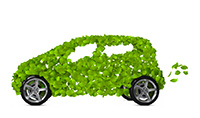Explore Possibilities

Car manufacturers are producing more energy-efficient vehicles.
Now that you have examined your challenge, brainstormed ideas and identified your constraints, it is time to start exploring some possibilities for creating your PSA.
Check out some examples of public service announcements:
> PSA: Take Pride in America
![]()
(from TakePride.gov)
> PSA: You are not just burning off calories...
![]()
(from Allison Gallant, Carnegie Mellon School of Design)
> PSA: Stop Water Pollution
![]()
(from Water Environment Federation)
> PSA: Think More Is Better?
![]()
(from Think Blue)
As you explore, think about:
- Who do you think is the intended audience for each PSA?
- What do you think works about these PSAs?
- What does not work?
- How do you want your PSA to be like or unlike the examples?
Take notes on page 9 in your Engineering Portfolio under item #5: Explore Possibilities.
Review any notes you have taken in your Engineering Portfolio, and conduct any additional research you need to explore possible PSAs. Keep track of your ideas for audience, text, images and placement of text and images on page 10 of your Engineering Portfolio. You may also wish to review the assessment rubric to make sure you understand how your final project will be graded.


